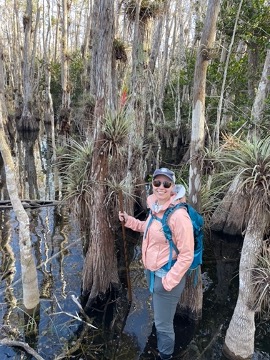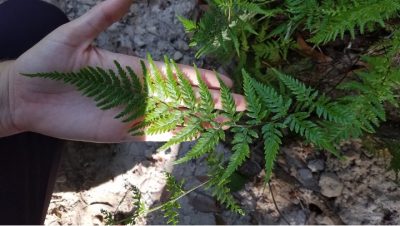
Dr. Emily Sessa
Photo Credit: Alan Cressler
Dr. Emily Sessa is currently an Associate Professor of Biology at the University of Florida. Research in the Sessa Lab focuses broadly on plant systematics and understanding the evolutionary and ecological processes that shape plant diversity. In this interview we learn more about Dr. Sessa’s current work and how she incorporates citizen science and iNaturalist into her research.
Who are you and what do you do?
I identify as a plant evolutionary biologist, primarily studying ferns and lycophytes. Research in my lab focuses broadly on plant systematics and understanding the evolutionary and ecological processes that shape plant diversity.
Why are ferns so cool?
Ferns play significant roles in the ecosystems where they occur. For example, they enhance biodiversity and contribute to nutrient cycling, create habitat for insects and other creatures, and more. They are found both in temperate and tropical climates; in tropical canopy ecosystems they are frequently epiphytes, and in the temperate zone they occur in the understory. There are approximately 10,000 species of ferns and they are the second largest group of vascular plants after flowering plants. They belong to one class in the Linnean hierarchy but include 48 different families, from tree ferns to water ferns to desert-adapted ferns.
Do you have a favorite genus or species?
Woodferns – the genus Dryopteris – are a longtime favorite. There is one species native to Florida, Dryopteris ludoviciana, whose common name is the southern shield fern. I have been studying how the genus as a whole has evolved and how the different species are related to each other. Another genus I’m currently studying is Asplenium, the spleenworts. Many species in this genus can be found growing in Florida, on limestone, as epiphytes, or on old logs. Sadly, many Florida spleenworts have become rare due to habitat loss. Evolution is a slow process and most species cannot adapt quickly enough to match the rate of climate change.
How are you using iNaturalist in your work?
There are two ways in which I use iNaturalist. First, as a personal field notebook, not just for ferns but also other plants and interesting species that I come across. Second, I use it to track ferns and lycophytes and scout populations of species that I’m interested in finding. Often when I see an observation that interests me, I will message the person that shared the observation to ask for further details and a more detailed GPS location so I can validate and further research the listed species. I am in the process of writing a book, a Field Guide to Ferns and Lycophytes of Eastern North America (scheduled to be published spring 2023), and I have been referencing iNaturalist in planning my research route and to seek out species.
Can you give us an example of a citizen science observation used to further research?
I noticed a rare species of fern documented in Manatee County through the iNaturalist platform and contacted the observer, who happened to be a member of the EcoFlora team at Marie Selby Botanical Gardens. I was able to get clear directions from her about the location of this species, Pityrogramma calomelanos (silver fern), a fern that can be found in many locations globally but that is pretty rare in Florida.
How can we improve the quality of our observations to make them most useful to researchers?
It is important to take good quality photographs, making sure they are not blurry, and as many as possible. For ferns, it’s really important to document the undersides of leaves (where the reproductive structures known as sori occur), the venation pattern, and take a variety of views including the base of plants near the soil line.
It is also important to consider the rarity of species and obscure the location in order to protect the species if needed. This will help avoid illegal collection or damage from visitors, and scientists can always send a message to the observer if they would like to locate and research the species.

Pityrogramma calomelanos
Photo credit: Anastasia Sallen
If you are interested in volunteering your time with the EcoFlora project and citizen science, please email ecoflora@selby.org to be added to our mailing list. In addition to making observations on your own time, each month we meet as a group at a particular Sarasota or Manatee County preserve or state park to observe and upload botanical observations. Join our January and February iNaturalist project, Finding Ferns, and begin documenting species today. If you would like to volunteer at our next BioBlitz February 9th 9am-12pm, at Lemon Bay Park, please register here.
